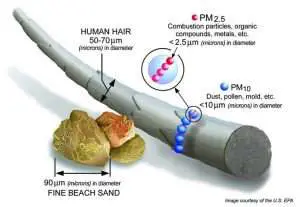You’ve decided to keep your baby room’s air smelling pristine and healthy. And, you’re about to buy the best baby room air purifier for your little one. But you’re wondering, do HEPA air purifiers for babies remove PM2.5 particles? Does even the finest HEPA air purifier for a nursery, bedroom, office, kitchen, or living room actually capture particles smaller than 2.5 microns?
In this post, I endeavor to give you a comprehensive response to this question and more.
But before I go a sentence further, I want to answer the question that brought you to this baby product reviews site….
Do Air Purifiers Remove PM2.5 Particles?
Yes, HEPA air purifiers DO remove PM2.5 particles. Actually, air purifiers that offer True HEPA filtration have the power to eliminate some of the smallest particles suspended in contaminated indoor air. According to the U.S. Environmental Protection Agency (EPA), a HEPA filter meets the rather stringent HEPA standard ONLY if it can remove at least 99.97% of the most penetrating particles — 0.3 micron particles.
But what do other voices say regarding this all-important question?
HEPA PM2.5 Removal Tests
While researching whether HEPA filters remove PM2.5, I bumped into someone who’d tested several air purifiers and found incredible results. In their experiments, HEPA filters demonstrated a clear ability to remove particles as small as 0.01 microns. Meaning the best machines of this kind should easily address indoor PM2.5 pollution.
IQAir air purifiers are marketed as having a HyperHEPA filter that’s able to filter the air down to 0.01microns. These powerful machines can remove solid particles and microscopic particles such as bacteria and viruses while handling smoke and VOCs just as well.
IQAir purifiers are awesome, but the downside is they’re almost prohibitively expensive. They’ll set you back almost $900. Additionally, the price of replacement filters of these heavy-duty HEPA air purifiers won’t make any parent smile.
What’s the Problem with PM2.5 Particles?
Anyone who attempts to dig around the web for information on PM2.5 particles soon gets overwhelmed by the tons of information on the topic. And there’s a good reason for that. Many clean air-craving parents want to be sure that the air purifier they plan on buying can actually protect their baby from the most dangerous type of airborne pollution, PM2.5.
PM2.5 Particles Are Microscopic and Super Nimble
PM2.5 particulates have the notoriety to reach the furthest body cells, causing unimaginable damage there. I cringe every time I’m walking some city street and I’m not wearing any PM2.5 protection. Every time a car whooshes by, I can smell PM2.5-packed exhaust fumes.
How many of these PM2.5 particles end up in my lungs and brain? I don’t know, but according to the World Health Organization, air pollution cuts short the lives of millions of people around the globe. That’s a scary thought, probably why you’re here. Here’s a FACT: PM2.5 pollution kills. Everyone who cares about their baby’s wellbeing must take quick action.
What Types of Particles Do HEPA Air Purifiers Remove?

So, good HEPA baby air purifiers take out a large percentage of the smallest and potentially the most lethal airborne particles. But what specific particles do these air purifiers remove?
Air cleaning devices that leverage the all-mighty true HEPA air filtration remove both PM2.5 and PM10 particles. Wait, what’s the difference between PM10 and PM2.5 particles? The main difference between is that PM10 particles are larger than PM2.5 particulates, which means they’re easier to remove.
While PM2.5 particles are those hovering around 0.3 microns or smaller diameter-wise, PM10 particles range between 2.5 microns and 10 microns in diameter. Your baby needs a HEPA air cleaner that effectively purges their room’s air of the vast majority of particles in these two particle size distributions.
Specific PM2.5 Particles
Pet dander, bird dander, or animal dander in general, dust, dust mite feces, mold spores, bacteria, viruses, Volatile Organic Compounds are all examples of PM2.5. Now, PM2.5 particles are extremely tiny and have a frightening cell and organ penetrating power. That’s why everyone that cares about their indoor air quality keeps searching for research and news about this sinister type of indoor pollution.
Most air purifiers, whether they use True HEPA filtration or use a different air purification technology, remove PM10 quite easily. But eliminating PM2.5 particles is a completely different ball game. These tiny particles easily pass through the main filter in certain air purifiers that pretend to offer HEPA filtration. That’s why you MUST choose an air purifier that’s rated to capture the smallest airborne air particles as easily as it does relatively large particles.
PM2.5 Particles are Ultra-fine
Another name for PM2.5 particles is Ultrafine Particles. As the name suggests, these particles are ultra fine and extremely hard to remove. That’s why parents who know anything about indoor air quality worry about these particles.
Because PM2.5 particles are infinitesimally small, a prefilter won’t remove them. To capture PM2.5 particles suspended in your baby nursery’s air, you need the most advanced HEPA air filter within your budget. You need a purifier whose main filter is a certified HEPA filter because that’s the only known weapon to win the battle against ultrafine particles.
When it comes to HEPA filters, there are different grades. Each grade represents a certain particle removing ability. A H10 HEPA filter won’t be as effective as an H13 filter. And an H13 filter certainly won’t be as great at capturing PM2.5 as an H14 allergen remover would be. So, make sure you understand what filter grade you’re getting with whichever air purifier model you’re eyeing.
If you want baby room air purifiers that freshen the air without costing you the whole world, consider brands such as Levoit, Medify, and Honeywell. But since some devices from these brands produce lung-irritating ozone, be sure to choose an ozone-free air purifier for your baby. Here’s a detailed baby room air purifier buying guide so you won’t end up with expensive crap.
Specific PM10 Particles (Coarse Particles)
PM10 particles are relatively large in diameter and include particles such as dirt clumps, pet hair, human hair, lint, fur, and suchlike. To remove PM10 particles, it’s best to vacuum clean your home and furniture frequently.
The next best approach is to install an air purifier that features a prefilter as part of a comprehensive multi-stage air filtration process. Most baby room HEPA purifiers employ a prefilter or in some cases 2 prefilters to filter out PM10 particles.
Another function of the prefilter is to increase the lifespan of the main filter by reducing the amount of workload it has to do. If you don’t want a money guzzler that works against your early retirement plan, go with an option that features a prefilter alongside the other filters.
By the way, there’s no link between long-term inhalation of PM10 and health issues. But it’s not like your baby wants to breathe dirty air.
The EPA, the entity mandated to issue air quality guidelines in the United States, has severally revised both the 24-hour and annual air quality standard for PM10 and PM2.5. The year 2012 was the latest they revised the standards, setting the 24-hour National Ambient Air Quality Standard for PM10 at 12 μg/m3 while retaining that of PM10 at 150 μg/m3.
What About VOCs and Smoke in the Baby Room?

I know the question you’re asking at this point: do HEPA air purifiers remove smoke particles? The answer is yes, HEPA-based air purifiers do remove smoke particles. However, HEPA air filters don’t do a thing when it comes to taking smoke particles out of indoor air. Because smoke particles, VOCS, and household odors pass right through a HEPA filter as though there’s nothing!
If HEPA filtration is pretty lame in terms of smoke removal, what makes HEPA purifiers able to capture smoke particles and VOCs in the nursery and elsewhere? It’s the odor filter, also known as the VOC filter.
The smoke filter heavily relies on activated carbon to adsorb smoke particles and other related kinds of particles. But does activated carbon or charcoal adsorb smoke particles from cigarettes, wildfires, or wherever?
Yes, active carbon adsorbs smoke particles and even VOCs from the air. That’s why cigarettes have a filter. According to Bansal and Goyal (2005), activated carbon is used the world over to remove hazardous gases and vapors among other critical uses such as water treatment and even gold recovery.
During water treatment, activated carbon is used to remove chlorine, undesirable taste, odors, and even VOCs. And in industrial gas processing, charcoal comes in handy when it comes to extracting hydrogen sulfide and siloxanes from biogas.
Also, according to Charles L. Gaworski et al in an article published in Research Gate, activated carbon filtration significantly adsorbs smoke constituents that characterize the vapor phase of mainstream smoke.
See, quite a few scientists and other carbon filtration experts all agree that charcoal is great at smoke smell elimination. So, when buying an air purifier for use in the baby room, make sure the device packs a substantial amount of active carbon in its charcoal filter.
True HEPA Vs HEPA Filters
When buying a baby room purifier or a purifier for any other room in the home, choose nothing short of True HEPA filtration. Some cunning marketers keep saying their device uses HEPA filters while in reality the filter is a HEPA-type one.
While a real HEPA filter captures at least 99.97% of 0.3 micron particles, a HEPA-like filter won’t usually filter out anything smaller than 2 microns. In other words, a HEPA-type filter won’t remove PM2.5 particles no matter what anyone out there in the marketing world says.
Final Thoughts on HEPA’s PM2.5 Removal Ability
True HEPA air purifiers remove PM2.5 particles. PM2.5 particles are 0.3 microns or smaller in diameter. These particles cause a lot of worry since their penetration power is enormous.
Always choose an air purifier that uses a certified True HEPA air filter rather than a HEPA-Type air filter. With the best PM2.5 air purifier, the air in the nursery should always feel clean, fresh, and above all, healthy. Your little one deserves the best. Give it to them.
I'm Esther Moni, a proud stay-at-home mom and a psychology graduate of the United States International University (USIU) . I hate it when anyone calls me a housewife, because what does housewife even mean? Being a mother of two babies and a pup, Bailey, as well as being Ricky's wife tires me to no end, but I still manage a smile at the end of it all. And when my boys aren't done doing mischief, I juggle writing a post on parenting or baby gear performance for this blog and running my little counselling office based out in Nairobi. <a href="https://www.facebook.com/esther.moni/">Visit my Facebook profile here</a>, and this is my <a href="https://ke.linkedin.com/in/esther-moni-3841b573/">LinkedIn profile</a>, and here's my <a href="https://www.youtube.com/channel/UCKcVb3NNDrURDH8C0KiAE1g/">nascent youtube channel.

